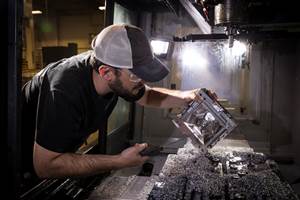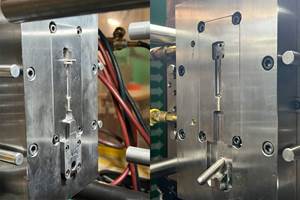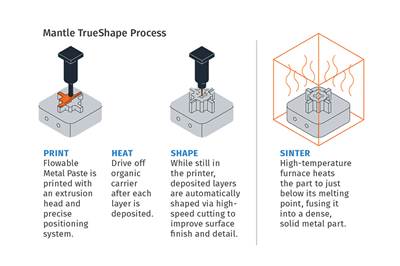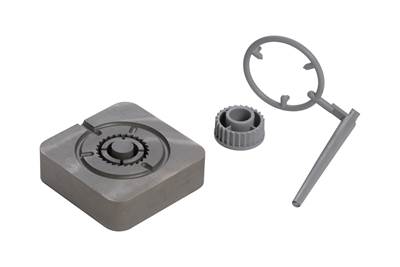Production Tool, Prototype Time
Mantle's metal 3D printing technology targeted toolmaking and injection molders and moldmakers are taking notice.
“Mantle lets you make a production tool in prototype time.” That’s the assessment of Mantle’s metal 3D printing system from Eric Derner of Nicolet Plastics who shared his view of the technology in a recent webinar by PT’s sister publication Additive Manufacturing. Derner is the technical sales applications engineer at the molder and moldmaker based in Mountain, Wisc. Following the acquisition of CNR Plastics in 2018 and the opening of a new plant in Ripon, Wisc. in 2021, the company now offers injection molding services from three sites.
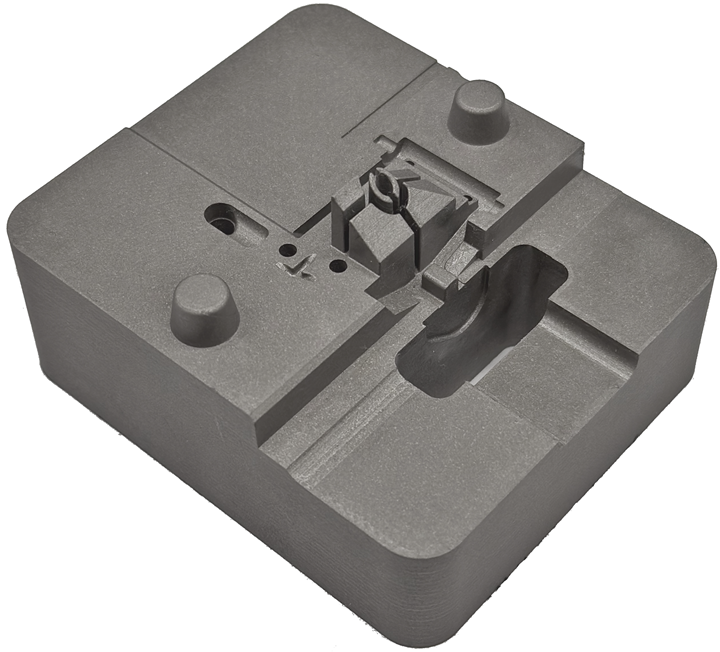
Nicolet printed three inserts for its customer Gamber-Johnson, with dramatic reductions in lead time.
Photo Credit: Mantle
The company’s recent expansions go beyond physical space to technology, including the addition of additive manufacturing in 2019 when it invested in a Carbon Digital Light Synthesis (DLS) 3D printer. Derner said the company chose Carbon because it viewed its output as mimicking injection molding “to the T.” This machine is used to help customers verify designs and some bridge production. Rapid parts, check; how about tooling?
“How Are We Going to Handle Tooling?”
Derner notes that Nicolet has several journeymen toolmakers at its facility in Mountain, as well as strong domestic and offshore tooling partners, but over the last few years as tooling lead times have gotten longer, requests for short-run molds have increased and quality moldmakers remain rare, Nicolet started to rethink molds.
“If you have a good moldmaker, hold onto them,” Derner said. “That’s why we started to look at Mantle. We thought, ‘How are we going to to handle tooling; how are we going to compete with China?’”.
The answer for Nicolet was Mantle and its TrueShape technology. The hybrid machine lays down layers of tool steel—H13 and P2X at this time—that come in a paste form. These layers are dried and machined with the printed green part then sintered into solid tool cavities. Mantle says the resulting components have a hardness of more than 50 HRC after heat treatment for H13 and 34 HRC for P2X. In terms of surface finish, Mantle says it achieves a 1-3 µm Ra/Charmilles 26/D2 finish, with accuracy of ±.001 in./in.
Like a standard tool steel, the printed parts are compatible with machining (milling, drilling, grinding, tapping, and EDM—both sink and wire); polishing (A2 finish possible); and texturing (chemical, deep chemical and laser etch). Before any metal paste is printed, dried, machined, sintered or polished, Mantle’s technology applies proprietary software to create the printing path with no programming required.
“No programming is really huge,” Derner said, pointing out the potential for hours of CAM programming in certain areas for conventionally machined tools, including if a part has ribs on core side, for instance. “All that is gone,” Derner said. “In a matter of five to 10 questions you have the toolpath and the elimination of CAM. You don’t need to run how to run a CAM system.”
Nicolet utilized the technology to assist its customer Gamber Johnson create a docking station component. Utilizing Mantle, Nicolet took lead time down from 6 weeks to 2 weeks. For a mold that would normally require some sinker EDM work, Nicole was able to print multiple steep-angled faces and thin ribs. Using H13 tool steel, the company printed three inserts with a print time 150 hours and sintering time of 36 hours, cutting overall mold building time from 180 hours to just 12 hours. Consider Nicolet sold — the company is slated to receive its own Mantle machine at the beginning of second quarter.

The printed inserts are now molding parts from a 35% glass-filled PA 6/6 for Gamber-Johnson.
Photo Credit: Mantle
Related Content
420 Stainless Steel Now Qualified With TrueShape 3D Printing Technology
NPE2024: Mantle's Additive Manufacturing Technology is Designed for Precision Tooling
Read MoreLarge-Format “Cold” 3D Printing With Polypropylene and Polyethylene
Israeli startup Largix has developed a production solution that can 3D print PP and PE without melting them. Its first test? Custom tanks for chemical storage.
Read MoreHow Additive Manufacturing Can Help, not Hinder, Injection Moldability of New Designs
Four cost drivers—design for moldability, mold-base size, internal componentry, polish/custom finishing—dictate the financial and processing success of a molded part design. Learn how 3D printing can assist this process, while also understanding its potential pitfalls.
Read More3D Printing of Injection Molds Flows in a New Direction
Hybrids of additive manufacturing and CNC machining can shorten tooling turnaround times.
Read MoreRead Next
Novel Metal 3D-Printing Technology Optimized for Plastic Tooling
A new company called Mantle offers 3D printing equipment and materials that boast unique suitability for producing injection mold components, overcoming limitations of other printing methods.
Read MoreMetal 3D-Printing Technology Targeting Tooling Is Launched
Following successful beta testing of the P-200 printer and TrueShape technology, Mantle has commercially launched its metal 3D printing system, with deliveries planned for the first half of 2023.
Read MoreWestminster Tool and Mantle Partner on 3D-Printed Mold Technology
The Connecticut mold maker will be one of two beta-testing sites for Mantle’s TrueShape metal 3D printer, with a medical device already borne out of an ongoing collaboration.
Read More

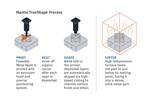
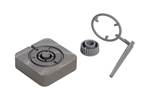










.png;maxWidth=300;quality=90)







